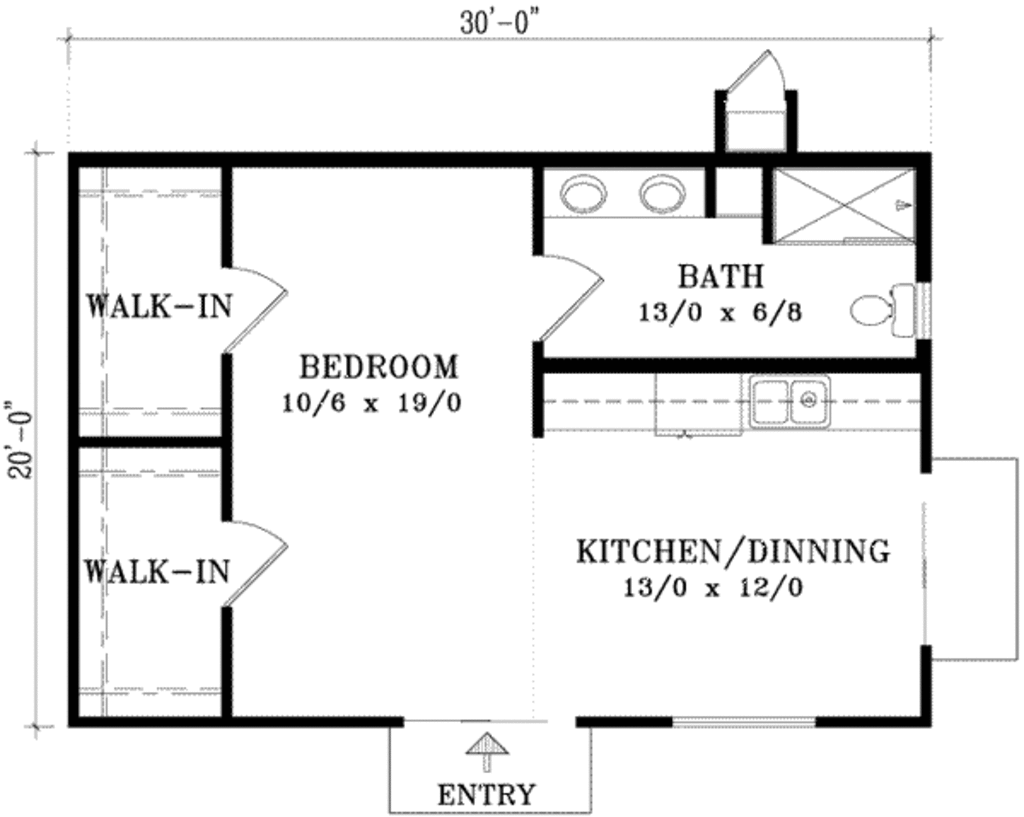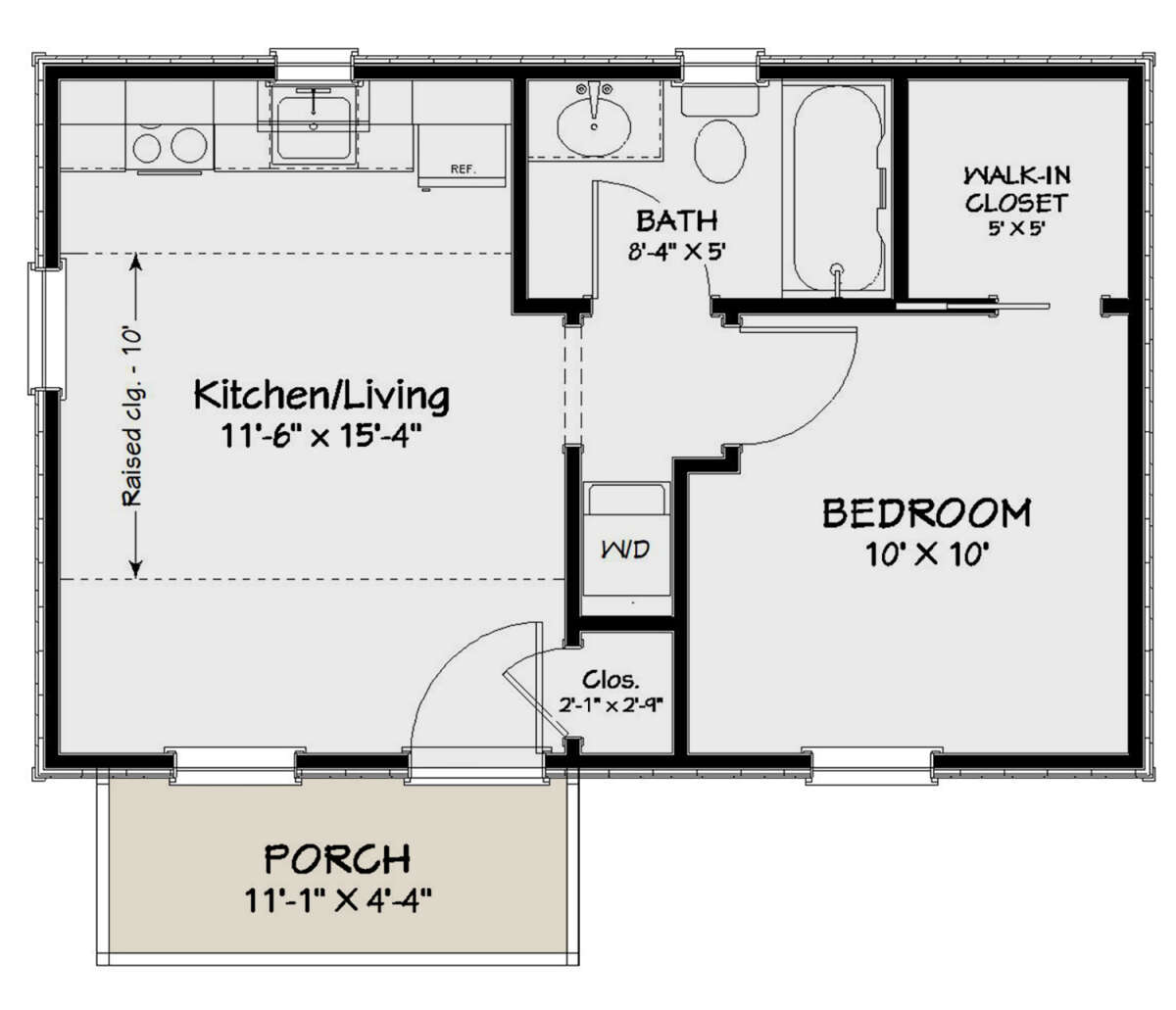Design Considerations for a 30×30 1-Bedroom House

Designing a comfortable and functional home within a 30×30 footprint presents both challenges and opportunities. The limited square footage necessitates creative solutions to maximize space and ensure efficient use of every area. This article explores key design considerations for a 30×30 1-bedroom house, including space-saving techniques, furniture arrangements, architectural styles, and strategies for maximizing natural light and ventilation.
Space-Saving Design Techniques
Space-saving design techniques are crucial for optimizing the functionality of a 30×30 1-bedroom house. These techniques help to create a sense of spaciousness while ensuring that every square foot is utilized effectively.
- Open Floor Plans: Eliminating walls between living areas, such as the living room, dining area, and kitchen, creates a sense of spaciousness and allows for greater flexibility in furniture arrangement.
- Multi-Functional Furniture: Utilizing furniture that serves multiple purposes, such as a sofa bed, a coffee table with storage, or a dining table that converts into a desk, maximizes space efficiency.
- Built-in Storage: Incorporating built-in shelves, cabinets, and drawers into the walls provides ample storage space without taking up valuable floor area.
- Vertical Storage: Utilizing vertical space by incorporating tall cabinets, shelves, and storage units maximizes storage capacity without encroaching on floor space.
Furniture Arrangements for a Small Footprint
Strategic furniture placement is essential for creating a comfortable and functional living space within a 30×30 footprint. The following furniture arrangements optimize space utilization and create a balanced and harmonious layout.
- Open and Uncluttered: Opting for furniture with a streamlined design and avoiding excessive clutter helps create a sense of spaciousness and allows for easy movement.
- Minimalist Approach: Choosing furniture pieces with clean lines and minimal ornamentation contributes to a sense of spaciousness and visual harmony.
- Floating Furniture: Utilizing furniture that is raised off the ground, such as a floating bed or a sofa with legs, creates a sense of openness and makes the space feel larger.
Architectural Styles for a 30×30 House
Several architectural styles can be effectively implemented in a 30×30 house plan. Each style offers unique design elements and aesthetics that can enhance the overall appeal and functionality of the home.
- Modern Style: Characterized by clean lines, open floor plans, and a minimalist aesthetic, modern style is ideal for maximizing space and creating a contemporary feel.
- Contemporary Style: Similar to modern style, contemporary architecture emphasizes simplicity, functionality, and natural light. However, it may incorporate bolder colors and textures.
- Minimalist Style: As the name suggests, minimalist style prioritizes functionality and simplicity, featuring clean lines, neutral colors, and a focus on essential elements.
Maximizing Natural Light and Ventilation
Maximizing natural light and ventilation is crucial for creating a comfortable and inviting living space within a 30×30 house. Here are some effective strategies for achieving this:
- Large Windows: Incorporating large windows throughout the house allows for ample natural light to penetrate the interior.
- Skylights: Installing skylights can bring in even more natural light and create a sense of spaciousness.
- Cross-Ventilation: Designing the house with windows and doors placed strategically to create cross-ventilation allows for efficient air circulation and natural cooling.
Layout Options for a 30×30 1-Bedroom House

Designing a functional and comfortable layout for a 30×30 1-bedroom house requires careful planning and consideration of space allocation. This size allows for a variety of layout options, each offering its own advantages and disadvantages.
Open Concept Layout
An open concept layout combines the living, dining, and kitchen areas into one spacious area. This creates a sense of openness and allows for better natural light flow.
- Advantages:
- Maximizes space and creates a feeling of spaciousness.
- Encourages interaction and social gatherings.
- Allows for flexible furniture arrangements.
- Disadvantages:
- Limited privacy, as all areas are visible.
- Can be noisy, as sounds easily travel throughout the space.
- May require more effort to maintain visual order.
Separate Living and Kitchen Layout
This layout separates the living area from the kitchen, providing a more traditional and distinct feel.
- Advantages:
- Offers more privacy, as the kitchen is separated from the living area.
- Reduces noise levels, as the kitchen is isolated.
- Allows for more defined spaces and furniture arrangements.
- Disadvantages:
- Can feel smaller and more cramped than an open concept layout.
- May limit natural light flow.
- Requires more careful planning to ensure adequate circulation.
Floor Plan Visualization
Here’s a basic visual representation of a 30×30 1-bedroom house floor plan using HTML table tags:
| Bedroom | Bathroom |
| Living Area | Kitchen |
This is a simplified example, and the actual layout would need to be tailored to individual needs and preferences.
Layout Options with Additional Spaces, 30×30 1 bedroom house plans
- Home Office: A small home office can be incorporated into the living area or a corner of the bedroom.
- Laundry Area: A compact laundry area can be integrated into the bathroom or a separate utility space.
Building and Budgeting Considerations: 30×30 1 Bedroom House Plans

Building a 30×30 1-bedroom house can be a rewarding project, but it’s crucial to carefully consider the costs involved. Understanding the different components of construction expenses, exploring cost-effective options, and implementing smart budgeting strategies can help you build your dream home within your financial limits.
Cost Breakdown for a 30×30 1-Bedroom House
The cost of building a 30×30 1-bedroom house can vary significantly depending on location, materials, labor, and design choices. Here’s a general breakdown of the main cost components:
- Land: The price of land varies widely based on location, size, and desirability. Research average land prices in your preferred area to get an estimate.
- Foundation: Foundation costs can range from $5,000 to $20,000, depending on the type of foundation (slab, crawl space, basement) and soil conditions.
- Framing: Framing costs typically range from $10,000 to $20,000, depending on the complexity of the design and the type of wood used.
- Roofing: Roofing costs can vary from $5,000 to $15,000, depending on the type of roofing material (shingles, metal, tile) and the roof’s pitch and size.
- Exterior Finish: Exterior finishes like siding, windows, and doors can range from $5,000 to $15,000, depending on the materials and complexity of the design.
- Interior Finish: Interior finishes, including drywall, flooring, paint, and trim, can cost from $10,000 to $25,000, depending on the materials and finishes chosen.
- Plumbing and Electrical: Plumbing and electrical costs can range from $5,000 to $15,000, depending on the complexity of the systems and the number of fixtures and appliances.
- HVAC: HVAC costs can range from $5,000 to $15,000, depending on the size and efficiency of the system and the climate.
- Permits and Inspections: Permit and inspection fees can range from $1,000 to $5,000, depending on local regulations and the scope of the project.
- Labor: Labor costs can represent a significant portion of the overall construction budget, ranging from 20% to 40% of the total cost. It’s essential to get multiple quotes from reputable contractors to ensure competitive pricing.
Cost-Effective Building Materials and Construction Methods
Choosing cost-effective building materials and construction methods can significantly impact the overall budget. Here are some suggestions:
- Foundation: Consider a slab foundation for a 30×30 house, as it’s generally less expensive than a crawl space or basement. However, ensure that the soil conditions are suitable for a slab foundation.
- Framing: While engineered lumber is more expensive than traditional lumber, it can be more efficient and reduce waste, potentially saving money in the long run. However, ensure that the design and specifications are suitable for engineered lumber.
- Roofing: Metal roofing is more durable and requires less maintenance than asphalt shingles, potentially saving money over the long term. However, metal roofing can be more expensive upfront.
- Exterior Finish: Consider using fiber cement siding instead of wood siding, as it’s more durable and requires less maintenance. However, fiber cement siding can be more expensive upfront.
- Interior Finish: Vinyl flooring is a cost-effective and durable option compared to hardwood flooring. However, vinyl flooring may not be as aesthetically appealing as hardwood flooring.
Design Choices to Minimize Construction Costs
Strategic design choices can help minimize construction costs without compromising functionality and aesthetics:
- Simple Design: A simple, straightforward design with minimal architectural details can reduce construction costs. Avoid complex rooflines, intricate window designs, and elaborate exterior features.
- Efficient Layout: An efficient layout that maximizes space utilization and minimizes wasted area can reduce material costs and labor hours. Consider using open-concept designs to create a sense of spaciousness without needing additional walls.
- Standard Materials: Using standard sizes and shapes of materials can help reduce waste and labor costs. For example, choose standard-sized windows and doors to avoid custom fabrication.
- Energy-Efficient Features: Incorporating energy-efficient features like insulation, high-performance windows, and efficient appliances can save money on utility bills in the long run. However, these features can add some upfront cost.
Budgeting and Managing the Construction Process
Creating a realistic budget and managing the construction process effectively are crucial for staying within your financial limits:
- Detailed Budget: Develop a detailed budget that includes all anticipated costs, including materials, labor, permits, and contingencies. Use a spreadsheet or budgeting software to track expenses and ensure you’re on track.
- Contingency Fund: Set aside a contingency fund of 10-20% of the total budget to cover unexpected costs. This fund can help prevent financial surprises and ensure the project stays on track.
- Contractor Selection: Choose a reputable contractor with experience building similar projects. Get multiple quotes and carefully review the contractor’s references and past work.
- Regular Communication: Maintain regular communication with the contractor throughout the construction process. Discuss any changes or issues promptly to avoid delays and cost overruns.
- Payment Schedule: Establish a clear payment schedule with the contractor. Make payments based on milestones achieved to ensure the project progresses as planned.